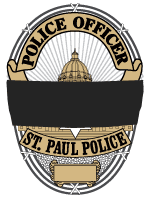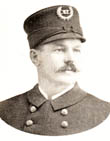HONOR ROLL
 |
Charles MayerAppointed December 1, 1888
|
|
Making his last rounds before being relieved of duty, Patrolman Charles Mayer1, Badge No. 28 and 110, of the Rondo Avenue Substation, was shot and killed at about 0220 hours (2:20 a.m.) on Saturday, February 1, 1902, after surprising three burglars at the rear of Louis S. Jessrang’s saloon in the City of Saint Paul while they were in the process of breaking into the drinking emporium. It is also thought that they may have had already broken into the nearby Spangenbert & Schlicting Butcher Shop at 323 University Avenue.
Patrolman Mayer was shot in the groin with a .44-caliber handgun at close range at the rear of the saloon, near the corner of University and Farrington Avenues, while he was “shaking doors” of the local businesses. With the officer slumping to the ground, the suspects made good their escape, leaving behind a bottle of nitroglycerine. Although fatally wounded, the officer was able to blow his whistle and fire his own handgun three times in rapid succession, calling for assistance. He died at about 0530 hours (5:30 a.m.) at Saint Joseph’s Hospital. It was later determined that the explosive component recovered was enough to have destroyed the entire building, to say nothing of blowing open the door of the small safe they would have found in the saloon.
The men who killed Mayer are believed to be the same suspects who had fired on Minneapolis Officer Frank Ford in a similar incident. Ford had caught the men boring holes in the rear door of S.A. Berni’s Saloon at 101 First Avenue South. One of the men fired at him, piercing his cap and grazing his skull. All three suspects were eventually arrested in Kansas and returned to Saint Paul, but had to be released due to lack of evidence and a key witness refusing to testify. One of the suspects, Jack Havlin (aka Jack Curtin), shot and killed Officer Lafayette A. Smith of the Omaha Nebraska Police Department during the commission of an armed robbery on January 13, 1909. Havlin was later shot and critically wounded during a shootout with an Omaha detective before being taken into custody. He died in the hospital nine days later.
Although police personnel records do not give a date of birth, other records indicate that Charles Mayer was born in about September 1861. Raised in Upper Silesia, Prussia and trained as a machinist, he immigrated to America in 1880, arriving in Saint Paul in about 1882. Forty-one year old Mayer had been with the Police Department since December 1, 1888 (fourteen years), working for many years out of the Rondo Avenue Substation’s bicycle squad, when his life was taken. He was survived by his second wife, Bertha, and six children, William, Henry, Matilda, Charles, Walter and Madeline, the youngest only three weeks old. An older son, George, died a month earlier and a younger son, Henry, died on February 5th. Patrolman Mayer’s funeral was held on Tuesday, February 4, 1902, in his home at 758 Sherburne Avenue using the burial service of the German Lutheran Church, and he is buried at the German Lutheran Cemetery (now Elmhurst Cemetery), Saint Paul, Minnesota. Participating in the funeral, along with many uniformed Saint Paul and Minneapolis police officers, was a contingent of the University Lodge A.O.U.W. (Ancient Order of United Workmen), of which Mayer was an active member.
Note: Patrolman Mayer’s daughter Matilda would later marry Saint Paul Police Roundsman Gustave H. “Gus” Barfuss2 on 20 October 1914. Barfuss would go on to be a key figure in the police department cleanup in the 1930s, was appointed Commissioner of Public Safety on June 2, 1936, and retired on June 1, 1948.
1 Charles Mayer was appointed Patrolman December 1, 1888; and was fatally injured by gunfire during an “on-tour” burglary investigation Saturday, February 1, 1902.
2 Gustave H. “Gus” Barfuss was appointed Patrolman January 20, 1912; was promoted to Motorcycle Roundsman July 1, 1916; was granted Military Leave August 11, 1918; returned to duty December 16, 1918; was promoted to Sergeant Nov 9, 1920; was promoted to Inspector of Traffic July 1, 1923; was promoted to Superintendent of traffic April 1, 1925; was promoted to Superintendent of Traffic & Radio Patrol March 20, 1930; was promoted to Director of Police Training August 1,1930; was promoted to Inspector of Police May 16, 1931; was promoted to Assistant Chief June 16, 1932; was granted Leave of Absence for appointment as Deputy Commissioner of Public Safety; returned as Assistant Chief (acting) July 31, 1935; was promoted to Assistant Chief (permanent) November 29, 1935; was appointed Commissioner of Public Safety June 2, 1936; and retired June 1, 1948.

